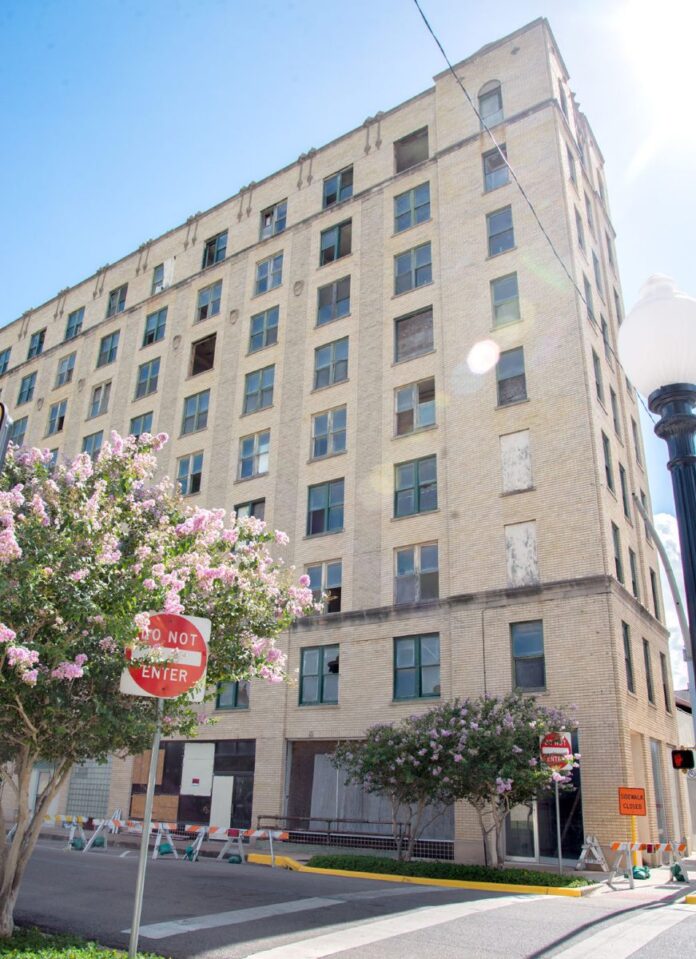HARLINGEN — For weeks, if not months, the plan to land federal tax credits to renovate the Baxter Building looked promising.
The Texas Department of Housing and Community Affairs’ preliminary review had given the project strong marks, heightening city leaders’ hopes for the historic renovation of the city’s tallest building.
But yesterday came unexpected news — the historic building’s proposed $4.3 million renovation project was denied the tax credits.
Now, the project’s developer will appeal the decision.
Yesterday, the Housing and Community Affairs agency denied developers MRE Capital credits to turn the city’s tallest building into a largely low-income apartment development.
But the agency placed the developer’s requested tax credits on hold pending appeal.
In its ruling, the agency said the developers failed to adequately address project costs and property management and mainte-nance expenses as well as the 90-year-old building’s structural condition.
The decision surprised city officials after the agency gave the project high scores in its preliminary review.
For the second time in two years, the agency’s adverse decisions have marked set-backs for Mayor Chris Boswell, who has planned on the renovation of one of the city’s biggest eyesores as a key to the continued revitalization of the downtown area.
What happens now?
Yesterday, City Manager Dan Serna said the decision will be appealed.
“We’re going to pursue the appeal process,” Serna said as he drove back from the agency’s board of directors meeting in Aus-tin. “Hopefully, we can clarify some of the points made.”
The agency denied the tax credits because the developer was “unable to assess major aspects of the cost of the develop-ment,” according to a state report.
According to the report, the developer “did not address likely costs not included in the project budget such as asbestos reme-diation, lead-based paint remediation, accessibility and fundamental concerns over the structure itself and whether its condition was sufficiently well known to … support the development of an appropriate scope of work.”
The report added, “the applicant’s proposed costs for property management and property maintenance (was) materially out of line with industry norms as to be beyond what they could accept.”
What opponents say
The appeal process will take at least three weeks, agency spokeswoman Kristina Tirloni stated.
Downtown property owners have opposed the project, arguing a 24-unit apartment development would bring too many families and cars into the small downtown business district.
Property owners are also concerned tenants would park their cars in front of businesses, taking parking spaces from shop-pers.
Bill DeBrooke, the owner of several downtown buildings who helped spearhead the downtown revitalization project in the late 1980s, proposed the city change its plans to turn the Baxter Building into an apartment development.
“I wish we had a better project for that site,” DeBrooke said yesterday. “We can put together something that would better com-plement downtown and be a benefit and an asset.”
Not quite
This year, it appeared the project stood a good chance of receiving federal housing tax credits, Serna said.
Boswell had said he was “cautiously optimistic” the developer would land the tax credits.
The state agency’s staff used its criteria to give the project 156 points, tying MRE Capital’s proposed Brownsville project while 12 other projects scored 155 points in Region 11.
The developers are requesting $335,545 in federal tax credits each year during a 10-year period for a total of $3.3 million, Serna said.
In Region 11, the 14 projects were requesting a total of $17.9 million in tax credits while $5.4 million was available.
Since last year, MRE Capital, a Kansas City, Mo., developer, has applied for tax credits as part of the plan to restore the nine-story building to its original condition while turning it into a 24-unit apartment development that would include 19 low-income units.
A look back
In late 2015, the city entered into an agreement with MRE Capital to renovate the Baxter Building, one of Harlingen’s biggest eyesores blamed for standing in the way of the downtown area’s revitalization.
On the condition of qualifying for tax credits, the developers would pay the Harlingen Community Improvement Board $250,000 for the Baxter Building while investing $4.3 million to restore it to its original condition.
Last year, the project scored low partly because prospective Baxter tenants’ children would attend Harlingen High School, which ranked below state academic standards.
Because the agency had coupled its public education criteria with its historical preservation points, the project lost critical marks.
But “extensive public comment” last year led the agency’s board of directors to revise the program’s criteria, spokesman Mi-chael Lyttle said.
So this year, the agency revised its criteria, separating its public education points from its historic preservation marks.
Last year, 66 out of a total of 125 applicants who filed for tax credits were awarded funding totaling $65.4 million, Lyttle said.
Texas Department of Housing and Community Affairs denial based on:
Developers unable to assess costs including asbestos and lead-based paint remediation
Concerns over the structure’s ability to support development
MRE Capital’s application
$335,545 worth of federal tax credits each year during a 10-year period for a total of $3.3 million
Baxter Building
Focus of a proposed $4.3 million renovation project
Renovation would create low-income apartment development
Harlingen’s tallest building at nine stories
Built as an office building in 1927
In disrepair since the 1960s





